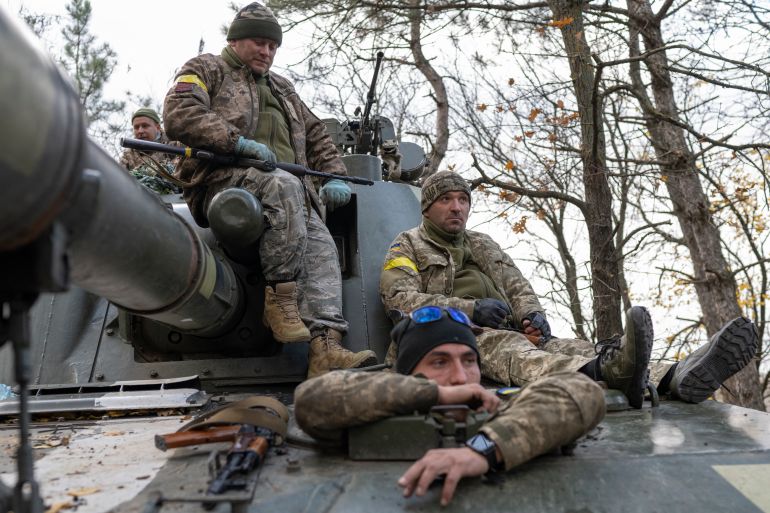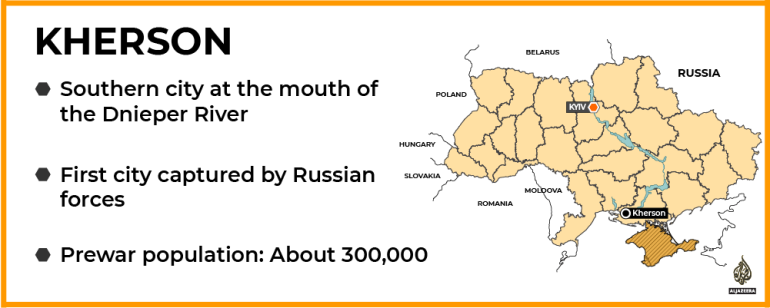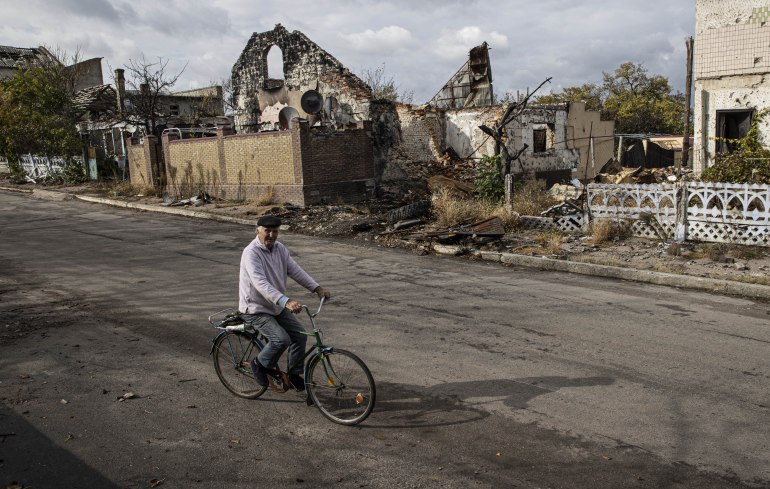‘Too loud to be true’: Is Russia setting a trap in Kherson?
Ukrainian troops are expected to make a bid for Kherson, one of four partially occupied provinces Russia annexed.

Kyiv, Ukraine – For days, the Kremlin has been trumpeting the evacuation of civilians from the key part of a southern Ukrainian region.
The Belgium-sized province of Kherson which serves as the gateway to the annexed Crimean Peninsula was seized days after the invasion began.
Keep reading
list of 3 itemsRussian authorities urge residents to leave Kherson ‘immediately’
Photos: Russian authorities ask civilians to leave Kherson city
Bisected by the mighty Dnieper River, Kherson became the first Ukrainian region to be fully occupied by Russia, and Moscow deployed tens of thousands of troops there.
Russia’s control of a chunk of the Dnieper’s west bank is especially important because it offers a chance to advance farther north and west.
But in recent weeks, Ukrainian forces retook dozens of villages and towns on the west bank and struck bridges, ferries and pontoons across the Dnieper and depots with surgical precision.
So, for the past 10 days, Moscow and its puppet “administration” in Kherson have been urging tens of thousands of civilians living on the west bank to leave for Crimea and mainland Russia.
They claimed that some 70,000 civilians evacuated voluntarily – and that they will be issued “certificates” for free housing anywhere in Russia.
“I am glad that everyone who wanted to promptly and safely leave the areas shelled by the Ukrainian military has done it,” Crimea’s “head”, Sergey Aksyonov, said late on Thursday.

Meanwhile, pro-Kremlin media reported that withdrawing Russian troops have taken away with them heavy bronze statues of two 18th-century Russian commanders.
Moscow’s official reason for the retreat is a claim that Ukraine is planning to bomb the Nova Kakhivka dam to flood the region; Kyiv rejects the allegation.
According to Ukrainian President Volodymyr Zelenskyy, the evacuation of civilians – and monuments – is nothing but a Kremlin-masterminded trap to create an illusion of panic.
“Their best-trained troops are in place. Nobody left. We see it and don’t believe them,” he told Corriere della Sera, an Italian newspaper, on Thursday.
A Ukrainian serviceman who spent months on the southern front lines says the Russian media buzz is too pre-calculated and loud to be true.
“We are not falling for it, because it’s too deliberate and designed to create media buzz, to create a certain mood,” the serviceman told Al Jazeera on condition of anonymity.
There is no hope for a miraculous retreat of Russians from such a strategic region, and Ukraine’s top brass needs to concentrate on improving the living conditions on Kherson’s front line, in the bare, windblown steppes that offer no shelter from the elements and Russian shelling, he said.
“A lot more has to be invested in the survival of the existing manpower,” he said.
Intelligence data and satellite photos show that, in recent days, Russians have been building fortifications and defensive lines in the regional capital, also named Kherson, and Nova Kakhovka, the town next to the dam and hydropower station.
“The evacuation of civilian residents from the [Dnieper’s] right bank to the left one is all preparations and propaganda tricks,” Ihor Romanenko, former deputy chief of Ukraine’s general staff of armed forces, told Al Jazeera.
“In fact, they’re strengthening their grouping there, with manpower. There’s more of it,” he said.
The grouping is even getting ready for a possible counterattack, he said.

In the first days of the invasion, Moscow hoped that its blitzkrieg would topple Zelenskyy’s government. But after weeks of heavy resistance and failures, it withdrew its forces from northern Ukraine and around Kyiv.
Moscow hoped to advance in the east and south to seize Ukraine’s Black Sea coast and pave the way to the breakaway pro-Moscow region of Transnistria, in neighbouring Moldova, where Russian “peacekeepers” have been stationed for years.
These hopes have failed too as Ukraine has liberated most of the eastern region of Kharkiv, dealt heavy blows to Russian forces in Luhansk and Donetsk, and started retaking parts of Kherson.
In recent days, heavy rains and muddy roads became another factor that slowed Ukraine’s advance, Romanenko said.
However, small groups of Ukrainian troops are constantly pin-pricking the Russians destroying command centres, depots, and supply routes and preventing the delivery of manpower, he said.
The timing of a decisive advance is yet to be determined.
“We have to identify the enemy’s weak spots, we have to gather reserves, increase our potential and only then make final decisions for more action,” he said.
Pro-Moscow figures claim that Russia’s recent decision to mobilise 300,000 men and destroy key Ukrainian infrastructure with cruise missiles, rockets and drones means Kyiv has no choice but to hastily move forward in Kherson.
“[Ukraine] is forced to hurry with an advance while its rear structures remain operational,” Igor Strelkov, a former “defence minister” in separatist Donetsk, who recently returned to the front line, wrote on Telegram on Sunday.
Another analyst said Ukraine’s stalled advance reflects its manpower shortages – and its increasingly cautious strategy of inching forward small groups.
“It can advance only after identifying sizeable breaches in the Russian defence,” Nikolay Mitrokhin, a Russia researcher at Germany’s Bremen University, told Al Jazeera.
Almost daily, the Ukrainian army suffers heavy losses, according to Russian reports, but keeps looking for new “holes”, he said.
“Such holes appear as a result of effective artillery fire or operation of drones, so, there are chances” for further gains, he said.
However, Russia promptly fills the holes with thousands of newly-mobilised troops even though they have next to no training and combat experience.
“That’s why Ukraine keeps hoping that its push-out tactics of hitting the rear, headquarters and the destruction of enemy manpower on the front line with artillery or drones that drop little bombs right on the soldiers’ heads will gradually work,” Mitrokhin said.